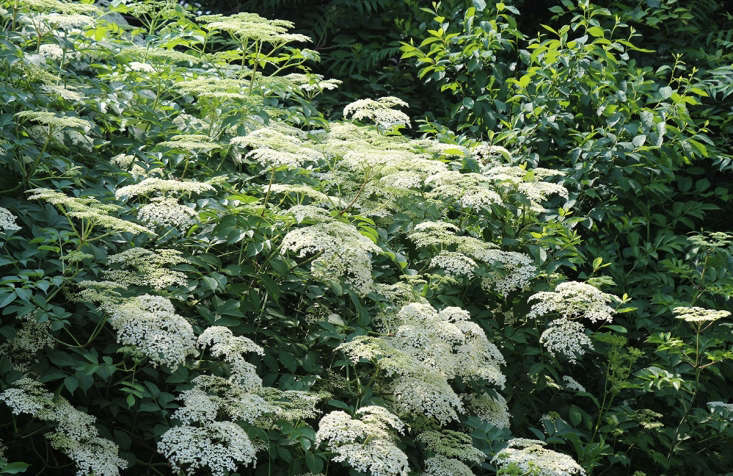For lovers of elderflowers, summer is a happy time. The large white flowering umbels festoon elder shrubs with pollen-laden blossoms, a magnet for honey bees and other pollinators. They are also irresistible to foragers: While Sambucus species are an ornamental boon to the gardener, their real reward is for the cook and the home-brewing alchemist.
Read on for my recipe for fermented elderflower cordial:
Photography by Marie Viljoen except where noted.
Elderberry in the Garden

These shrubs have a reputation for being weedy: They grow fast and spread via stolons (horizontal stems that shoot up new growth), forming dense colonies in spots they favor, especially near water. For foragers in the urban or rural wilds this prolific habit is good news, because we love the flowers, and the famous berries run a close second (at least for me). Because elder shrubs in full bloom are arrestingly attractive, I suggest bringing the wild home by planting them in your kitchen garden (whether it is private or communal).

If you do not want elderberry to spread, check for suckers several times in the growing season and shear them off. Elders respond well to hard pruning; I cut mine back hard for shape and productivity in late winter.

I grow my shrub in a large pot (18 inches in diameter). Pruning roots every three years or so is beneficial (those stolons will still be trying to spread in the pot and can cause girdling, which deprives the plant of nutrients).
Elderberry Flowers


Avoid collecting the blooms right after heavy rain as it will have rinsed some pollen and wild yeasts away. You want both.
Marie’s Fermented Elderflower Cordial (A Fizz)

Ingredients:
- 6 ounces or approximately 30-35 elderflower umbels
- 1 pound sugar
- 6 cups water
- 1/2 cup (about 3-4 lemons-worth) fresh lemon juice
- Zest of 4 lemons, peeled in strips, or zested with a microplane
Step by Step

Do not wash the flowers, or you will lose wild yeasts and the flavorful pollen. Instead, shake them upside down over a cloth to evict any small insects. Strip the tiny white flowers from the green stems, using your fingers. Discard as much green as possible (in any plant it will add a tannic note, but with elderflowers the green is toxic). Weigh the flowers and pack them lightly into a large, clean mason jar or jars. Dump the sugar on top of them.

Add the cool water, the lemon juice and the zest, stir well, and screw the lid on loosely or simply secure double layers of muslin over the top of the open jar with string or a rubber band. At this stage the ferment actually needs air. The cloth is to keep fruit flies and insects out.
Leave the jar at room temperature for about four days. Fermentation times vary according to yeasts and temperatures and the water you use. Stir once a day with a long-handled clean spoon.
When you notice a lot of bubbles pushing through the floating flowers, and notice the elderflowers rising and pushing up out of the jar, give the mixture one more day. Then strain the liquid through a fine mesh strainer into a clean bowl. Strain again through double layers of cheesecloth.
N.B.: After the cordial is strained I re-use the still flavorful dregs (called pomace in winemaking terms) for infused vinegars and even marmalade. If I have more flowers I make a concentrated elderflower syrup, which is not fermented, and remains beautifully clear.
Bottle in clean bottles. Plastic bottles are more reassuring if you are nervous about possible explosions; the plastic bulges out when over-carbonated, giving you a very good clue that pressure should be released. If you are using glass bottles I recommend sturdy square-sided sauce bottles from Specialty Bottle. Avoid light, thin glass. You can store the cordial in a cool cupboard, but for peace of mind store the bottles in the refrigerator, where the cold temperature will retard any additional fermentation.

Above: Enjoy your hard work. Stir together Noilly Prat vermouth and a dash of elderflower cordial, pour over ice, and add some thinly sliced lemon. Ah, summer!
More Elderberry Recipes

Above: Photograph by Mia Wasilevich. There are more uses to elderflower. In her new book Ugly Little Greens—Gourmet Dishes Crafted from Foraged Ingredients California-based wild chef Mia Wasilevich infuses butter with the blossoms and poaches lobster tails in the fragrant fat. I have used her method to make delicious potted shrimp. Mia also includes creative recipes for elderflower sangria, gelato, tres leches cake, and corn cake.














Have a Question or Comment About This Post?
Join the conversation (4)